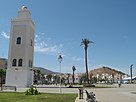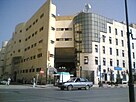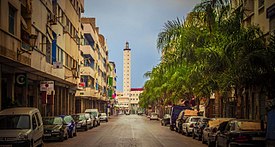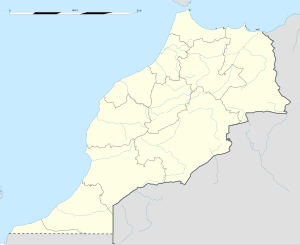Nador
Nador Ennaḍur / ⴻⵏⵏⴰⴹⵓⵔ / الناظور | |
|---|---|
City | |
    | |
 Nador Ennaḍur / ⴻⵏⵏⴰⴹⵓⵔ / الناظور Location in Morocco | |
| Coordinates: 35°10′N 2°56′W / 35.167°N 2.933°W / 35.167; -2.933 | |
| Country | |
| Region | Oriental |
| Province | Nador |
| Government | |
| Elevation | 42 m (138 ft) |
| Population (2014)[1] | |
| • Total | 159,590 |
| • Rank | 19th in Morocco |
| • Ethnicities | Berbers: 98%; Spaniards: 1%; Other foreigners: 1% |
| Time zone | UTC+1 (CET) |
Nador (Berber: Ennaḍur, ⴻⵏⵏⴰⴹⵓⵔ; Arabic: الناظور) is a coastal city and provincial capital in the northeastern Rif region of Morocco with a population of about 161,726 (2014 census).[1] It is separated from the Mediterranean Sea by a salt lagoon named Sebkha Bou Areq (Arabic), Bḥar Ameẓẓyan (Berber) or Mar Chica (Spanish) and is 10 kilometres (6.2 mi) south of the Spanish city of Melilla. Nador was founded in the 19th century and was under Spanish rule until Morocco’s independence in 1956.[2]Nador Province has over 600,000 inhabitants, predominantly of Riff-Berber ethnicity. Nador Considers as the Second Largest City in The Oriental East after Oujda.
Contents
1 Etymology
2 Overview
3 Demographics
4 Geography
4.1 Nature
5 Climate
5.1 Neighborhoods
6 Nador transmitter
7 Transport
8 Economy
8.1 Tourism
Etymology
The origin of the city name is disputed. It may have originated from Has Nador, which was a small village by the lagoon, or it may have come from Arabic terms meaning either lighthouse[3] or sight.[2]
Overview
The economy of Nador and Nador province includes fishery, agriculture, some light and heavy industry. The economy has grown dramatically in recent years, particularly due to the manufacturing sector with the building of a metal processing complex supplied with iron ore from Wiksan, a mountain in the Rif range, anthracite from Jerada, textiles, chemicals and some electronics industries.[4]
In the summer months of June to August thousands of people originating from the Nador area and living in Europe return to the city. The total of these annual visitors may exceed 250,000. They mainly stay with relatives or in rented or owned apartments, rather than staying in Nador's hotels.
The location of the city on the Mediterranean coast and proximity of the Spanish town Melilla mean there is significant international trade, particularly evident in the widespread sale of Spanish manufactured foodstuffs and household goods in Nador.
Nador was infamous as a centre of smuggling cheap Spanish and Chinese duty-free goods. Currently the smuggling has declined but it still alive competing with a smuggling stream from Algeria. Many used consumer goods from Europe and China find their way to Morocco and Africa via Melilla and Nador, both legally and illegally. The goods range from conserved food, clothes, shoes, electric home appliances, up to sophisticated hardware.[5][6]
Demographics
It has recently become a fast-growing city,[7] despite experiencing a population drop with the departure of the Spanish, when the population decreased from 23,000 in the early 1950s[8] to less than 5,000 in 1960. Nador’s population grew by 566% between 1960 and 1971, from 4,806 people in 1960 and 32,000 in 1971.[9] Its population has since grown with over 500% once again, to a total estimated population of 200,000 in 2015.[10] Only eight years previously, in 2007, the city had a population of 120,000.[11] 98 percent of the city-population is made up by Riffian-Berbers. The Amazigh culture is dominant and Nador is the largest Tarifit-speaking (one of the Tamazight languages) city in the world.[12] The population density in the city of Nador is many times that of the larger Nador Province.[13]
Geography
Nador is the 19th largest city in Morocco and is the capital of Nador Province in the Oriental Region of northern Morocco. It is located on the Sebkha Bou Areq lagoon on the Mediterranean coastline. The city sprawls along the coast. It is approximately 75 kilometres (47 mi) west of the Algerian border, 10 kilometres (6.2 mi)south of the Spanish enclave of Melilla, and 380 kilometres (240 mi) east of the Moroccan capital of Rabat. The city center of Nador is largely a grid of streets around the north-south axis of Avenue Hassan II, with the main bus- and taxi stations at its southern end. Avenue Mohammed V runs from the city’s waterfront to the city's governmental facilities and town hall on its east end.[14][15] Mohammed V Boulevard has open plazas and Spanish Iberian-style architecture, particularly seen in the Roman Catholic churches.[16] The administrative city center, main post office, and the Grand Mosque are all located on the Youssef Ben Tachfine Boulevard.[17]

Great Nador by night.
Nature
The salt lagoon off and to the east of the city attract wildlife, especially migratory birds [18][19] Bird species in the protected wetlands at Oued Moulouya and Kariat Arekman by the Moulouya River mouth include the Greater pink flamingo, Great crested grebe, Avocet,[20]Black-winged stilt, Coot, Dunlin, Oystercatcher, Audouin's gull, Grey heron, Little egret, Spotted redshank, Black-tailed godwit, Common redshank, Kingfisher, Black tern, and numerous other species of terns and gulls.[2][21] As well as being a safe haven for birds, this area is frequently visited by locals because of its natural environment.[citation needed] There are major freshwater and saline sites covering large areas of protected sand dunes, marsh- and swampland. Insects include Damselfly, Caelifera, and numerous others. The flora includes Marram grass, Juniper, Cistus, and more.[2]
Climate
In Nador, there is a local steppe climate. In winter there is more rainfall than in summer. The Köppen-Geiger climate classification is BSh. The average annual temperature in Nador is 18.7 °C (65.7 °F). About 313 mm (12.32 in) of precipitation falls annually.
| Climate data for Nador | |||||||||||||
|---|---|---|---|---|---|---|---|---|---|---|---|---|---|
| Month | Jan | Feb | Mar | Apr | May | Jun | Jul | Aug | Sep | Oct | Nov | Dec | Year |
| Average high °C (°F) | 16.6 (61.9) | 17.2 (63) | 18.9 (66) | 20.8 (69.4) | 23.5 (74.3) | 26.7 (80.1) | 29.6 (85.3) | 30.1 (86.2) | 27.8 (82) | 24.6 (76.3) | 20.7 (69.3) | 18.1 (64.6) | 22.9 (73.2) |
| Average low °C (°F) | 8.4 (47.1) | 8.9 (48) | 10.7 (51.3) | 12.4 (54.3) | 15.0 (59) | 18.0 (64.4) | 20.7 (69.3) | 21.8 (71.2) | 19.5 (67.1) | 16.2 (61.2) | 12.4 (54.3) | 10.0 (50) | 14.5 (58.1) |
| Average precipitation mm (inches) | 52 (2.05) | 37 (1.46) | 33 (1.3) | 38 (1.5) | 21 (0.83) | 7 (0.28) | 1 (0.04) | 3 (0.12) | 16 (0.63) | 24 (0.94) | 33 (1.3) | 48 (1.89) | 313 (12.32) |
| Source: Climate-Data.org,Climate data | |||||||||||||
Neighborhoods
Main Nador city quarters and neighbourhoods include:
- Teraqqa'a (حي ترقاع)
- El Khettabi (El Xeṭṭabi)
- El Kindy (El-Kindi)
- Laarasi (Laɛraṣi)
- Anafag / Elmatar / New Nador / Ennaḍur Amaynu (الناظور الجديد)
- Laari Shikh (Laɛri n Eccix)
- Ammas n Temdint / Centro / Centre ville (Downtown Nador)
Downtown Nador: a relatively developed area in comparison with the rest of the city. This lies in the centre of the city and was partially developed during the Spanish occupation of northern Morocco.
- Ulad Mimun (Ayt Mimun)
- Isebbanen
- Ichumay (Icumay)
- Aarrid (Ɛarriḍ)
- Ulad Barhim
- Tireqqaâ / Tireqqaɛ
- Ayt Leḥsen
- Erfid / Ibarraqen
Nador transmitter
Near Nador is the transmission site for long- and short-wave Medi 1 Radio which broadcasts to all Maghreb countries. The aerial masts of Medi 1 Radio for long-wave are approximately 380 metres high and are among the tallest man-made structures in Africa.
Transport

Gare Nador Ville main entrance
A railway linking Nador to Taourirt was opened on 2 July 2009 by king Mohammed VI of Morocco.[22][23] as part of ONCF's rail projects. Previously, there was a connecting bus link from Taourirt, also operated by railway company ONCF[24]
In addition, several direct bus links operate between Nador and major Moroccan cities. Daily ferry services link Nador Port with Almeria in Spain and a weekly service to Sète in France.
Nador International Airport offers direct flights to Moroccan and European destinations, such as cities in France and Germany, and acts as a second airport for travellers to and from Melilla.
Roads give access to the Fes-Oujda expressway and to nearby Melilla.
Economy
The main two economic industries here are the fishing- and agricultural industries. Other types of industrial income is generated from textile-, chemical-, numerous metallurgical industries. Recently, also tourism has become an important factor for the economy.[25] Most tourists come from other Moroccan cities,[26] but Nador has also an increasing number of European visitors for instance through the international ferry connections to Spain and France.[27]Nador International Airport, in which opened in 1999,[27] also serves numerous European cities, including but not limited to flights to Amsterdam, Brussels, Frankfurt, Marseille, and Barcelona. The two Nador railway stations connect to the rail network of the country of Morocco. The recent boost in tourism here has inspired ambitious tourism plans for the area, endorsed by King Mohammed VI.[28] With its avenues, palm-lined boulevards and brand new marina, hotels, cafés, banks, shops and restaurants press on to make it suitable for the fast-growing tourism industry.[10][15] Nador has experienced a dramatic economic growth in recent years, fueled by traditional industries, such as metallurgy, and by modern ones, i.e. electronics, chemicals, and textiles. Older industries as fishing and agriculture are still the most important income for Nadoris. Beni Enzar, on the edge of Nador, is home to Nador Port, which is one of the most crucial fishing ports on the Mediterranean coast. Nador Port also has modern naval dockyards.[10] Nador’s farm land is extremely fertile,[29] and the main agricultural resources are fruits, citrus, and wine-grapes.[27]
Tourism
During the summer months, Nador is visited by hundreds of thousands of Moroccan migrants living in Europe, who are originating from the province or from the city of Nador itself. These summer visitors contribute strongly to the development of the city, by buying property, helping their families, and by stimulating the overall local trade and tourism. Like in other cities, king Mohammed VI also wants to attract foreign tourists, and for this reason ordered the local governors whom he appoints, to try to give the city a better look: cafés have been told to use metal or wooden chairs outside (and not plastic ones), houses have to be painted in appropriate colours throughout the city, and the main boulevard along the sea has been redeveloped and widened.
Until early 2008 the city end of the boulevard was formed by the Rif Hotel, but in the spring of 2008 the existing hotel was demolished and the road alongside the boulevard opened and extended. This new road by-passes the city centre and runs directly towards the main roundabout at the entrance of Nador via the Road to Tawima. The remaining grounds where the hotel and its facilities were located is being redeveloped into a new hotel complex: after some delay the new hotel development is being built under supervision of Khalid El Adouli.[30] The new Rif complex is being built on the grounds of the former hotel minus the strip land directly on the coast as this is now a road and a public boulevard, which is on reclaimed land[citation needed]
The new hotel will be target the high-end tourism market and also cater for business users with congress-facilities. Once re-opened it will (again) offer a discothèque (serving alcoholic beverages) and congress or party rooms. The hotel itself will offer 110 4**** rooms, including 10 suites and also 76 apartment rooms. The budget for the redevelopment of the hotel is 356 Million Dirham and the total usable floorspace will be 30.000 m²[31]
Just outside Nador a new ecological resort is being developed Abdouna Trifa including holiday homes, a golf course and a marina. The total size of the new resort consists of 720.000 m² built area on a terrain of 480 hectare. The start of this 10 year development plan was done in 2008 by Mohammed VI, the King of Morocco[32] Both this project as well as the new RIF Hotel are being developed by CGI: Compagnie Générale Immobiliere, an activity of the CDG Group.[33]
When completed the resort will consist of approx. 1700 "villas", 1300 apartments, a 4* and a 5* hotel. The development also includes a 27-hole golf-track and several other tourist facilities.
| Wikivoyage has a travel guide for Nador. |
Art
^ ab "POPULATION LÉGALE DES RÉGIONS, PROVINCES, PRÉFECTURES, MUNICIPALITÉS, ARRONDISSEMENTS ET COMMUNES DU ROYAUME D'APRÈS LES RÉSULTATS DU RGPH 2014" (in Arabic and French). High Commission for Planning, Morocco. 8 April 2015. Retrieved 29 September 2017..mw-parser-output cite.citation{font-style:inherit}.mw-parser-output q{quotes:"""""""'""'"}.mw-parser-output code.cs1-code{color:inherit;background:inherit;border:inherit;padding:inherit}.mw-parser-output .cs1-lock-free a{background:url("//upload.wikimedia.org/wikipedia/commons/thumb/6/65/Lock-green.svg/9px-Lock-green.svg.png")no-repeat;background-position:right .1em center}.mw-parser-output .cs1-lock-limited a,.mw-parser-output .cs1-lock-registration a{background:url("//upload.wikimedia.org/wikipedia/commons/thumb/d/d6/Lock-gray-alt-2.svg/9px-Lock-gray-alt-2.svg.png")no-repeat;background-position:right .1em center}.mw-parser-output .cs1-lock-subscription a{background:url("//upload.wikimedia.org/wikipedia/commons/thumb/a/aa/Lock-red-alt-2.svg/9px-Lock-red-alt-2.svg.png")no-repeat;background-position:right .1em center}.mw-parser-output .cs1-subscription,.mw-parser-output .cs1-registration{color:#555}.mw-parser-output .cs1-subscription span,.mw-parser-output .cs1-registration span{border-bottom:1px dotted;cursor:help}.mw-parser-output .cs1-hidden-error{display:none;font-size:100%}.mw-parser-output .cs1-visible-error{font-size:100%}.mw-parser-output .cs1-subscription,.mw-parser-output .cs1-registration,.mw-parser-output .cs1-format{font-size:95%}.mw-parser-output .cs1-kern-left,.mw-parser-output .cs1-kern-wl-left{padding-left:0.2em}.mw-parser-output .cs1-kern-right,.mw-parser-output .cs1-kern-wl-right{padding-right:0.2em}
^ abcd http://www.marokko-info.nl/english/nador/
^ Honnor, Julius (2012). Morocco Footprint Handbook. Footprint Travel Guides. Page 397.
ISBN 9781907263316.
^ Morocco. Dorling Kindersley Eyewitness Travel Guides. 2006.
^ Info about Nador and Smuggling visited on 6 May 2008
^ LookLex page on Nador visited on 6 May 2008
^ Hardy, Paula and Athony Ham (2007). Morocco. Lonely Planet. Page 208.
ISBN 9781740599740.
^ Seddon, David (1981). Moroccan Peasants: A Century of Change in the Eastern Rif, 1870-1970. Dawson. Page 242.
ISBN 9780712909303.
^ Pennell, C.R. (2000). Morocco Since 1830: A History. NYU Press. Page 329.
ISBN 9780814766774.
^ abc Warson, Lucilla (2015). DK Eyewitness Travel Guide: Morocco. Penguin. Page 162.
ISBN 9781465438324.
^ Hardy, Paula and Athony Ham (2007). Morocco. Lonely Planet. Page 208.
ISBN 9781740599740.
^ Honnor, Julius (2012). Morocco Footprint Handbook. Footprint Travel Guides. Page 397.
ISBN 9781907263316.
^ Seddon, David (1981). Moroccan Peasants: A Century of Change in the Eastern Rif, 1870-1970. Dawson. Page 199.
ISBN 9780712909303.
^ Honnor, Julius (2012). Morocco Footprint Handbook. Footprint Travel Guides. Page 398.
ISBN 9781907263316.
^ ab Clammer, Paul (2014). Lonely Planet Morocco. Lonely Planet. Page 221.
ISBN 9781743600252.
^ Laura M. Kidder and Sullivan, Mark (2009). Morocco. Fodors Travel Publications. Page 53.
ISBN 9781400008049.
^ Honnor, Julius (2012). Morocco Footprint Handbook. Footprint Travel Guides. Pages 397-398.
ISBN 9781907263316.
^ Clammer, Paul (2014). Lonely Planet Morocco. Lonely Planet. Page 397.
ISBN 9781743600252.
^ (in German) Kohlbach, Edith (2006). Reisehandbuch Marokko. Edith-Kohlbach-Reisebücher. Page 51.
ISBN 9783981086829.
^ Searight, Susan (1999). Maverick Guide to Morocco. Pelican Publishing. Page 272.
ISBN 9781455608645.
^ French, Carole (2010). National Geographic Traveler Morocco. National Geographic Books. Pages 133-134.
ISBN 9781426207068.
^ Le train Nador-Taourirt, enfin sur les rails, FesPub.net.
^ King inaugurates Nador stations Archived 2009-08-28 at the Wayback Machine.
^ Timetables for the bus link can be found on the ONCF website Archived 2008-06-14 at the Wayback Machine..
^ Oxford Business Group (2007). Oxford Business Group. Page 202.
ISBN 9781902339764.
^ Oxford Business Group (2011). Oxford Business Group. Page 123.
ISBN 9781907065309.
^ abc Searight, Susan (1999). Maverick Guide to Morocco. Pelican Publishing. Page 271.
ISBN 9781455608645.
^ Jacobs, Daniel and Keith Drew (2013). The Rough Guide to Morocco. Penguin. Section: Nador.
ISBN 9781409332671.
^ (in German) Kohlbach, Edith (2008). Ostmarokko. Edith-Kohlbach-Reisebücher. Page 36.
ISBN 9783941015005.
^ Profile of Khalid El-Adouli, managing architect of the new Rif hotel development. Visited: 7 September 2012
^ Information on hotel redevelopment from RKempo Community site, visited 7 September 2012
^ Press-release of CGI about Start of development Abdouna Trifa (French), 15 July 2008. Downloaded: 7 September 2012
^ Website CGI: Our organisation (French), visited 7 September 2012
Coordinates: 35°10′0″N 02°56′0″W / 35.16667°N 2.93333°W / 35.16667; -2.93333
